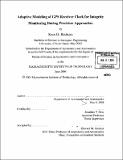| dc.contributor.advisor | Jonathan P. How. | en_US |
| dc.contributor.author | Bednarz, Sean G. (Sean Garrett), 1980- | en_US |
| dc.contributor.other | Massachusetts Institute of Technology. Dept. of Aeronautics and Astronautics. | en_US |
| dc.date.accessioned | 2005-06-02T18:31:32Z | |
| dc.date.available | 2005-06-02T18:31:32Z | |
| dc.date.copyright | 2004 | en_US |
| dc.date.issued | 2004 | en_US |
| dc.identifier.uri | http://hdl.handle.net/1721.1/17756 | |
| dc.description | Thesis (S.M.)--Massachusetts Institute of Technology, Dept. of Aeronautics and Astronautics, 2004. | en_US |
| dc.description | Includes bibliographical references (leaves 98-100). | en_US |
| dc.description.abstract | The FAA is developing the Local Area Augmentation System (LAAS) to replace ground-based navigation aids as the primary means of aircraft precision approaches. Stringent requirements on the integrity of the system have caused significant delays and raised questions about the adopted approach to integrity monitoring. The system architecture must be capable of detecting when the position estimation error exceeds the alert limit, with a probability of missed detection less than 10⁻⁷ for Category I approaches. This thesis offers a new approach to integrity monitoring that exploits an overlooked resource: the receiver clock. Conventional GPS positioning requires the estimation of four parameters. In addition to three position components, the receiver clock offset from GPS time must be found. Clock-aided positioning involves removing this fourth unknown by using a stable atomic frequency standard to keep time. This not only frees up one extra pseudorange, but it changes the structure of the problem from four-parameter to three-parameter estimation. The result is a drastic improvement in the vertical dilution of precision (VDOP), which leads to enhanced accuracy of vertical position estimates. Laboratory data shows accuracy improvements ranging from 34% to 44%, while field tests performed in a moving vehicle show 28% to 49% improvement using clock-aided positioning. Clock-aiding can provide an even greater benefit in integrity monitoring. The error in a clock bias estimate obtained from pseudorange measurements is a good predictor of the error in the corresponding vertical position estimate. Thus, we can estimate four parameters as before, and exploit the knowledge that we know part of the answer (clock bias) to serve as a quality check on the position | en_US |
| dc.description.abstract | (cont.) estimate. Using an adaptive clock model based on precise carrier phase measurements, the clock bias error can be estimated and a corresponding Vertical Protection Level (VPL) established. This approach automatically adjusts for the measurement quality, accounting for atmospheric disturbances, changing multipath conditions and other error sources. This thesis establishes the potential of clock-aided integrity monitoring, showing that a VPL based on clock bias prediction error predicts error peaks, adjusts to changing conditions and bounds the vertical position error for a modest data set. | en_US |
| dc.description.statementofresponsibility | by Sean G. Bednarz. | en_US |
| dc.format.extent | 100 leaves | en_US |
| dc.format.extent | 3324847 bytes | |
| dc.format.extent | 3334649 bytes | |
| dc.format.mimetype | application/pdf | |
| dc.format.mimetype | application/pdf | |
| dc.language.iso | eng | en_US |
| dc.publisher | Massachusetts Institute of Technology | en_US |
| dc.rights | M.I.T. theses are protected by copyright. They may be viewed from this source for any purpose, but reproduction or distribution in any format is prohibited without written permission. See provided URL for inquiries about permission. | en_US |
| dc.rights.uri | http://dspace.mit.edu/handle/1721.1/7582 | |
| dc.subject | Aeronautics and Astronautics. | en_US |
| dc.title | Adaptive modeling of GPS receiver clock for integrity monitoring during precision approaches | en_US |
| dc.title.alternative | Adaptive modeling of Global Positioning System receiver clock for integrity monitoring during precision approaches | en_US |
| dc.type | Thesis | en_US |
| dc.description.degree | S.M. | en_US |
| dc.contributor.department | Massachusetts Institute of Technology. Department of Aeronautics and Astronautics | |
| dc.identifier.oclc | 56524650 | en_US |
